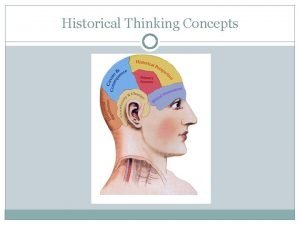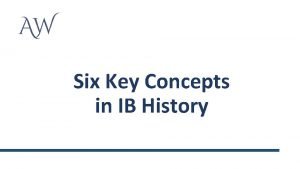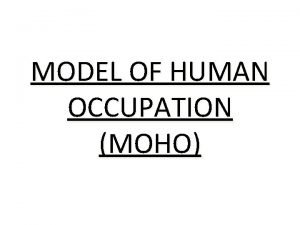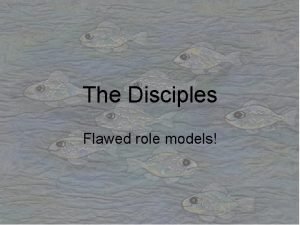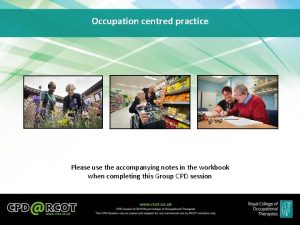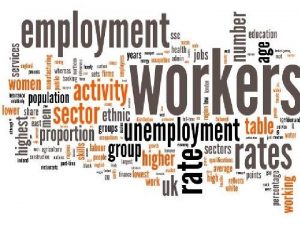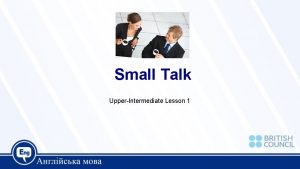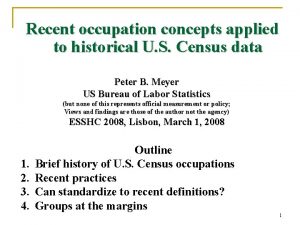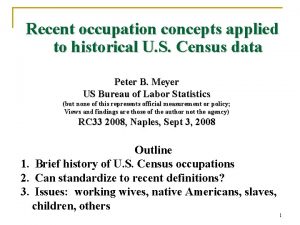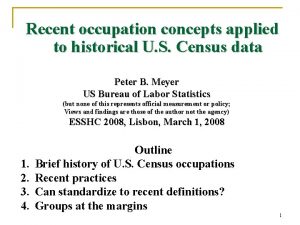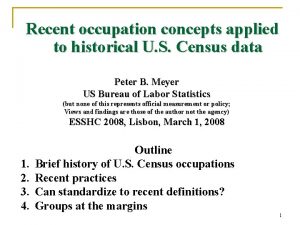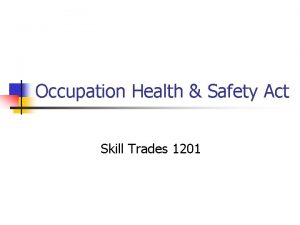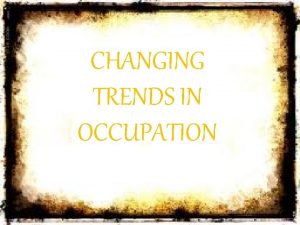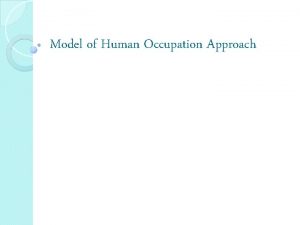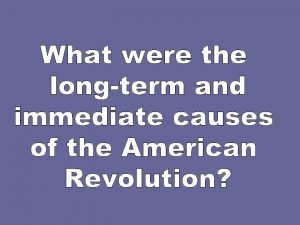Recent occupation concepts applied to historical U S











- Slides: 11

Recent occupation concepts applied to historical U. S. Census data Peter B. Meyer US Bureau of Labor Statistics (but none of this represents official measurement or policy; Views and findings are those of the author not the agency) ESSHC 2008, Lisbon, March 1, 2008 1. 2. 3. 4. Outline Brief history of U. S. Census occupations Recent practices Can standardize to recent definitions? Groups at the margins 1

Relevant history of U. S. Census occupation concepts n n n n n Constitution requires counts every ten years for defining political districts and taxes by state. It excludes Indians (Native Americans). First collected in 1790. Idea of collecting occupations recurs. 1850: “Profession, occupation, or trade” asked. 1870: Slave category disappears. 1902: Bureau of Census established. 1920: Most Indians now included in principle. 1950 and since: Relatively stable practices. 2

Can standardize occupation categories over time that look like recent ones? n IPUMS (Matt Sobek) defined occ 1950 for 1850 -present n Meyer and Osborne (2005) defined 1990 -based classification from 1960 to present. Plan to improve, correct, and extend that. Let us look at recent Census practices occupation variable. n Census “coders” in a single location assign 3 -digit industry and occupation codes n They follow carefully documented practices. n I interviewed four experienced ones. n They work just north of Louisville, in Jefferson, Indiana 3

Information used when coding n “what kind of work" “most important activities or duties" employer name “what kind of industry” home city and state years of education age sex n before 1994, had income too n This information is available when choosing “industry” and “occupation” n n n • Tens of thousands of job titles are mapped to a code in a reference book they have, if industry matches what is expected. • Some cases may be "autocoded" by software; coder checks. • Coder with two years experience should assign 94 codes per hour with 95% “accuracy”, which is checked. • Cases not meeting the rules go to “referralist” (specialist) 4 • They have 9+ years of experience.

Problems faced by referralists n Having to hurry n Ambiguity; too little information from respondent q q q n “computer work" for “kind of work” "water company" for industry or employer "surveyor" occupation "boot" vs "boat" in handwriting exaggeration (example: dot com businesses) Referralists confer with each other routinely, but sometimes make different choices from one another 5

Tangential motivation: Example of standardizing n n In 1960 Census, “lawyers and judges” was one category Later, “lawyers” and “judges” were separate We can impute which 1960 ones are judges for standardizing comparisons to later data. In 1970 -1990 these variables predict who’s called a judge: q q q q Employed in public sector, especially in state government Older Employed in state government High salary income Low business income Educated less than 16 years Employed at time of survey 6

Newly Imputed Judges Using that information in a logistic regression, can assign some to new “judges” category. 1960 1970 1980 1990 Lawyers 1971 2570 5082 7603 Judges 82 123 298 331 Seems to be 80% accurate. In this case, can estimate a time series of earnings separately for judges and lawyers more accurately. Let us go back to look at the earlier period to see how far it is from this data-processing world. 7

Census year Notes; the question Census asked 1790 -1840 Censuses No specific occupation question. Census collected by U. S. marshals. 1850 "Profession, occupation, or trade of each male person over 15 years of age" and "Number of slaves" 1860 "Profession, occupation, or trade of each person, male and female, over 15 years of age" and "Number of slaves" (without work details) 1870 Slave category disappears. "Profession, occupation, or trade of each person, male or female" 1880 Census enumerators are no longer marshals. "Profession, occupation, or trade of each person, male or female" over age 10 and, of those, months unemployed during the census year. Separately, months at school. 1890 ""Profession, trade, or occupation" and, of those, months unemployed during the census year 1900 Hunt (1909) refers to 1893 international standard. Bose (2001) estimated dramatic undercount of women in 1900 and presumably before. 1910 1920 Permanent Census Bureau started 1902. Most Indians now included, but most were not included in 1910. 8

Category of persons Relation to occupation categories Indians (Native Americans) Excluded, by Constitution; over time, most descendants have become U. S. citizens or showed up in Census data, e. g. could have occupations Slaves Counted separately; did not have occupations 1860; then that disappears legally and as a data category Adult women Not counted in 1850. Occupations dramatically undercounted, per Bose (2001), especially if it were informal and through an ethnic enclave. By 1900 Census definition 22. 5% employed; by 2000 definition, 46. % did. Children or students Minimum age for an occupation has jumped around from 15 to 10 to 14 to 16. "Student" is recorded in some years but is not by usual definition an occupation. Retired, unemployed Sometimes these are given categories in the occupation category system Non-citizens, border-crossers Household location matters; employer's location doesn't. Institutionalized In prison, hospital, disabled, charity shelter. Can have an occupation but usually don't. Working illegally or avoiding tax Can be categorized in a Census occupation. No link to law enforcement. However before 1880, Census enumerators were law enforcement officials. Volunteers or hobbyists Not counted as in an occupation unless they report as self-employed Apprentices Yes, if paid. If not paid, might be conceived of as students. Homeless; can't locate; traveling Can have an occupation based on information from others or remote location. Refused to answer Historically a small category. Can have an occupation if enumerator receives information from others (I believe). Possibly a growing category. 9

Tentative conclusions n n Realistic to apply current occupation concept back to 1910 -1940, sometimes earlier Before 1930 it makes sense to adjust for adult women in home-based economy and Indians In 1850 maybe only 35% of population would have a “Census occupation”; now 65% or more. More research is feasible to get better at this. 10

The information coders have 11
